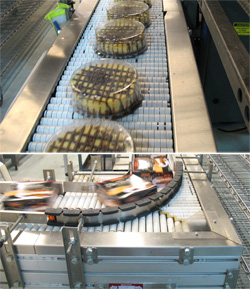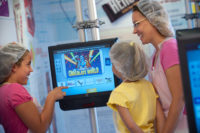
Culinary Art's Specialties' new automated packaging line, equipped with smart conveyor technology, processes 2,700 frozen cheesecakes per hour with a product integrity rate of 99.9 percent
Culinary Art’s Specialties, Inc. is all about cheesecake manufacturing. The company was founded in 1982 by Arthur P. Keller, a Swiss pastry chef who developed an exclusive Swiss baking process now used in the company’sThe processor’s main focus is in the private-label retail segment, which accounts for 80 percent of its business. The company delivers a full line of in-plant, contract manufacturing services ranging from product development to manufacturing to packaging.
Having recently expanded its production space from 18,000 sq. ft. to a 53,000-sq.-ft. plant, the company’s cheesecake making operation is new from the ground up. The facility has the capacity to produce, freeze and ship 150,000 pounds of the dessert each week-30,000 cheesecakes each day.
To sustain this throughput, Culinary Art’s added new production equipment, including five new mixers with 1,300-, 800- and 400-lb. capacity; eight new filling machines to improve filling line versatility, handling everything from dry crumb filler to piston fillers; new baking ovens; three new freezers-a -30°F blast freezer for freezing the cakes after baking, a 0°F holding freezer and another 0°F, 40-foot-high, 200-pallet freezer for holding finished product. Expanded cooler capability was also put into the raw materials storage area.
Handling cheesecakes requires a delicate touch to prevent marring the cakes. Nowhere in the production process is the handling of the product more critical than in the end-of-line packaging, and particularly in the conveying of the cheesecakes through the packaging cycle. Yet many systems that handle such delicate desserts run a high defect rate resulting in damaged products, lessened throughput and increased production costs.
“When we planned the move to our new building, we redesigned the entire production process,” says Art Keller, vice president of operations for Culinary Art’s Specialties. “We started from scratch and designed a facility that was cut out to do exactly what we wanted it to do-manufacture the world’s best cheesecakes with a very high level of throughput efficiency without sacrificing product quality.”
“Our prior packaging lines were largely manual,” says Keller. “We manipulated the cheesecakes by hand. One of the challenges we needed to solve with the design of the automated system was moving our cheesecakes through the packaging line before they are shrink-wrapped without having them touch anything, as this would mar the product. Additionally, we wanted to minimize the amount of cheesecake residue deposited on the conveying system for food safety reasons. We looked at a number of conveyor systems, but they permitted too much contact with the cheesecakes. It was a huge issue for us.”
Culinary Art’s brought in Shrink Packaging Systems to handle the integration of the shrink-wrapper and Shuttleworth to engineer a solution to the conveyor handling of the product and set up the cheesecakes for induction into the shrink-wrapper.
“We needed the conveyor to automatically center the product for infeed into the shrink-wrapper,” says Charlie Meyer with Shrink Packaging Systems. “And we needed to generate as little backpressure as possible to not only protect the cheesecakes from banging into each other, but to properly set up the cakes for induction into the wrapper. The spacing had to be very precise, a tolerance of 0.25-0.5 inch. Shuttleworth had the conveyor technology to accomplish these needs.”
The shrink-wrapper used on this line is an automatic, horizontal, continuous-motion side sealer rated at a maximum 100 cycles per minute. Shuttleworth engineered two different solutions. First, to keep the product from touching the sides along the 16-foot stretch of conveyor prior to entering into the shrink-wrap unit, and to center the cheesecakes, it designed a sequential series of different-height rollers that form a type of funnel into the middle of the conveyor.
Second, the conveyors are also equipped with Slip-Torque technology, which minimizes cheesecake damage by creating extremely low back-pressure accumulation. Low line pressure throughout the continuous-motion accumulation conveyors allows for precise product placement throughout the line and into the shrink-wrapper.
The all-stainless steel conveyors can continue to take product flow from the upstream line for a period of time instead of stopping. A low-pressure accumulation buffer absorbs irregularities in the production flow, and provides a smooth, even flow on the line, which minimizes the cheesecakes from bumping into each other.
When the cheesecakes leave the shrink-wrapper, they are placed into cartons. The conveyor runs parallel to the cartoner and is synchronized with it. As a cheesecake passes on the conveyor in front of a worker, the cartoner presents an open carton and the worker manually slides it into the carton. The conveyor/product and carton are precisely sequenced.
The conveyor then rotates the cartons and indexes them into a printer that stamps a date code on the cartons as they pass the printer.
“Shuttleworth designed this part of the conveyor with tightly spaced rollers so we get a perfectly smooth motion as the boxes go by the print head,” continues Keller. “The resulting code is very legible. With our prior system, we were having difficulty with blurring of the printed codes because of vibration as the cartons were passing.”
A 40-foot section of conveyor then routes the cartons to a case packing machine, where again, the low back-pressure accumulation system of Slip-Torque is used to stage the cartons for induction into the case packer.
The conveying capability has enabled the company to automate and streamline its entire packaging line. While improving on the product quality it had with its manual processes, it has been able to transfer this product integrity to its automated system.
“The packaging line automation has reduced our product defects to less than one-tenth of one percent, while increasing our throughput,” Keller explains. “This significantly surpasses what we could do on a manual level. With the success of this line we are now building-out a second automated packaging line to further streamline our cheesecake production.”
For more information, contact Linda Grush, 260-359-7844 or visit Shuttleworth’s website.
